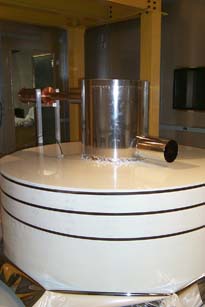Inquiring Minds
|
Physics at Fermilab main page | accelerators | collider experiments | neutrino physics | technology computing | theory | astrophysics | discoveries at Fermilab |
|
|
|
|
Based on thorough observations of the sky, astrophysicists noticed years ago that the shape and motion of galaxies and other objects cannot be explained with visible matter, the matter we know from stars and planets. The data suggested gravitional forces that can only be explained by what physicists called dark matter. Many speculations exist about the origin and composition of dark matter.
One can calculate the abundance of these particles in the universe today. If these particles are to provide the mass necessary to prevent the universe from expanding for ever, their interaction with other matter must be very weak and their mass should be in the range 10 GeV to 10,000 GeV. (For comparison: the mass of a proton equals 1 GeV.) These properties gave rise to the name WIMP. Gravitational forces should keep WIMPs within our galaxy. We can imagine a cloud of WIMPs clumped around our galaxy, with the solar system sweeping through this cloud as we orbit the center of the Milky Way. WIMPs could easily travel through regular matter, like the earth, and the particles should have a mean velocity relative to the earth of about 300 km/s. Building a detector here on earth, physicists try to identify the WIMPs. They look for massive particles that occasionally create tiny signals inside their detector as the detector moves through the "WIMP wind." To reduce the number of other effects that could create similar signals, physicists shield the detector and keep it ultracold. Presently in operation at the Stanford Linear Accelerator Center, the CDMS detector will soon be moved to its new location at the bottom of an old mine in Soudan, Minnesota. Fermilab participates in the experiment. |
| last modified 2/26/2001 email Fermilab |
FRLsDFx9eyfrPXgV



 The Cryogenic Dark Matter Search (CDMS) experiment is looking for dark matter in the
form of Weakly Interacting Massive Particles, or WIMPs. One attempt to solve the dark
matter problem hypothesizes the existance of an undiscovered particle already existed
in the very early universe.
The Cryogenic Dark Matter Search (CDMS) experiment is looking for dark matter in the
form of Weakly Interacting Massive Particles, or WIMPs. One attempt to solve the dark
matter problem hypothesizes the existance of an undiscovered particle already existed
in the very early universe.